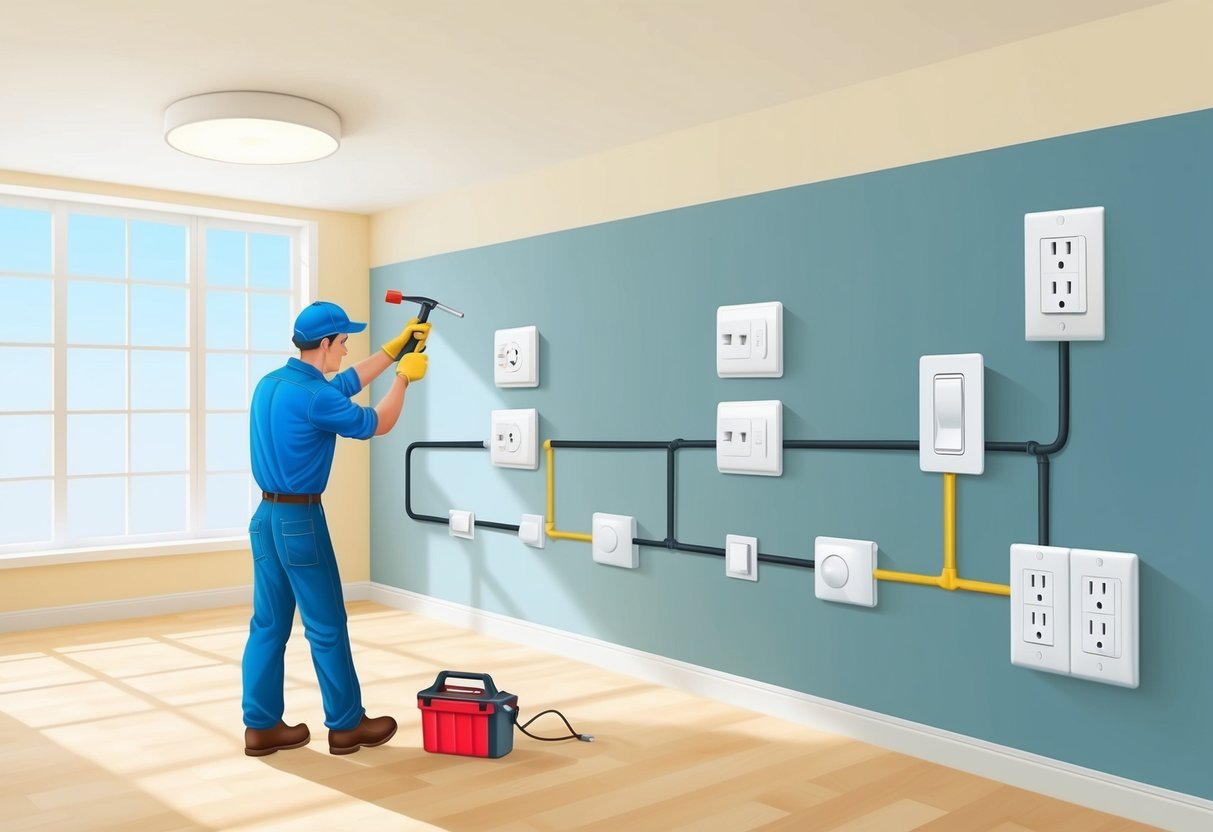
Understanding Your Home’s Electrical System
Homes depend on intricate networks of wiring, electrical circuits, and protective devices to safely deliver power to outlets, switches, and light fixtures. Knowing how these systems function helps homeowners safely troubleshoot issues and recognize when repairs are necessary.
How Electrical Circuits Work
Electrical circuits direct the flow of electricity from the main service panel throughout the home. Each circuit forms a path from the panel to groups of outlets, switches, and eventually returns back to the panel, completing a loop.
When a device is plugged in and switched on, the circuit conducts electricity along insulated wires. Most homes have separate circuits for high-demand appliances and general use, reducing the risk of overload.
Common signs of circuit problems include flickering lights, unresponsive outlets, or frequent tripping of circuit breakers. If too many devices draw power on one circuit, a breaker may trip, cutting electricity to prevent overheating.
Simple solutions for circuit overloads include unplugging devices or redistributing them across different circuits. Understanding the path and capacity of each circuit is crucial for safe DIY electrical repairs.
Key Components of Residential Wiring
Modern electrical systems use copper or aluminum wires, usually encased in color-coded insulation for easy identification. The most common electrical wires found in homes include:
| Wire Type | Typical Use | Color Insulation |
|---|---|---|
| Hot | Carries current in | Black/Red |
| Neutral | Returns current | White |
| Ground | Safety path for faults | Green/Bare |
Outlets and switches are connected to these wires using secure screw or push-in terminals. Junction boxes, required wherever wires are spliced, provide both protection and accessibility for inspection or repairs.
Regular inspections of visible wiring, outlets, and switches can help prevent electrical hazards caused by damaged insulation or loose connections. Persistent issues like sparks, buzzing sounds, or a warm outlet may signal an underlying wiring issue that needs prompt attention.
The Role of Electrical Panels and Circuit Breakers
The electrical service panel, sometimes called the breaker box or fuse box, operates as the control center for the home’s electrical system. It divides incoming power into individual circuits and houses circuit breakers or fuses for safety.
Each breaker is designed to cut power automatically if a circuit is overloaded or a short circuit occurs. Routine checks of the service panel ensure that breakers function correctly and no wiring problems have developed.
Residents should also test and reset GFCI outlets monthly as an extra level of protection in areas prone to moisture. Common warning signs that the electrical panel or breakers need professional evaluation include frequent breaker trips, burning smells, or any visible signs of heat or corrosion.
A properly maintained electrical service panel is essential to reduce the risk of electrical fires and protect all devices in the home.
Troubleshooting Common Outlet Problems
Electrical outlet issues are a frequent concern in homes, often leading to dead outlets, burnt smells, or intermittent power. Understanding how to inspect, diagnose, and safely address these problems is critical for maintaining a reliable electrical system.
Diagnosing Faulty or Dead Outlets
When an outlet stops working, the cause can be anything from a tripped circuit breaker to an internal wiring fault. The first step in troubleshooting is to check whether other outlets on the same wall or nearby are functioning.
Next, inspect the circuit breaker panel and reset any tripped breakers. If outlets in kitchens, bathrooms, or outdoors are not working, they might be connected to a GFCI outlet.
Pressing the “reset” button on the GFCI can often restore function. For more detailed instructions on fixing dead outlets and GFCIs, review this guide on electrical outlet troubleshooting.
Other common causes include loose wires, blown fuses, or damaged receptacles. Use a voltage tester to confirm power presence before disassembling any outlet.
Disconnect devices and lamps, then test the outlet directly. If no voltage is found and no external causes are detected, the outlet itself may be faulty and require replacement.
Fixing Burnt or Damaged Outlets
A burnt outlet is a serious electrical hazard. Signs to look for include black scorch marks around the receptacle, melted plastic, or a persistent burnt smell.
These problems are typically the result of overloaded circuits, worn wiring, or loose connections overheating.
Key steps:
- Turn off power at the main breaker.
- Unscrew the outlet cover and gently pull out the receptacle.
Inspect for blackened terminals or charred wiring. Burnt receptacles should always be replaced, not repaired.
If the wiring insulation is damaged beyond just the visible outlet, call a licensed electrician to inspect the whole circuit. Learn more about fixing or replacing burnt outlets.
Addressing Loose Connections in Outlets
Loose connections inside an outlet are a common cause of flickering lights, intermittent power, or sparking receptacles. Outlets with wires pushed back into the device instead of being firmly attached to screw terminals are more susceptible to loosening over time.
Here’s a brief troubleshooting checklist:
- Switch off power.
- Remove the outlet cover and gently tug each wire.
If wires slip out or feel loose, re-strip and reattach them under the screw terminals for a secure connection. Check both the hot (usually black or red) and neutral (white) wires, as well as the ground.
Use a screwdriver to tighten connections firmly, avoiding excessive force that could damage the terminal. For a more detailed DIY guide, see these steps to repair loose or problematic outlets.